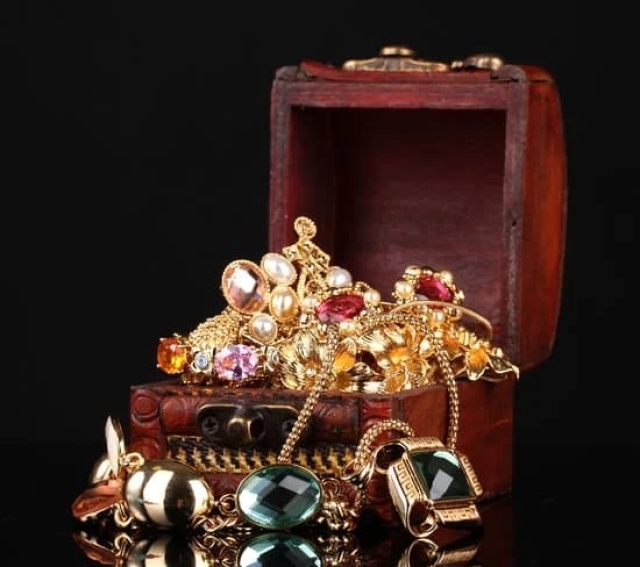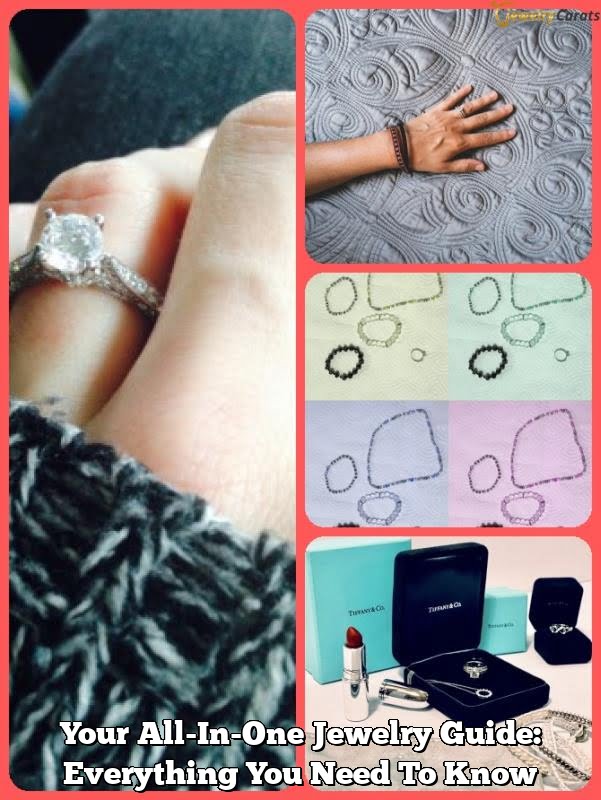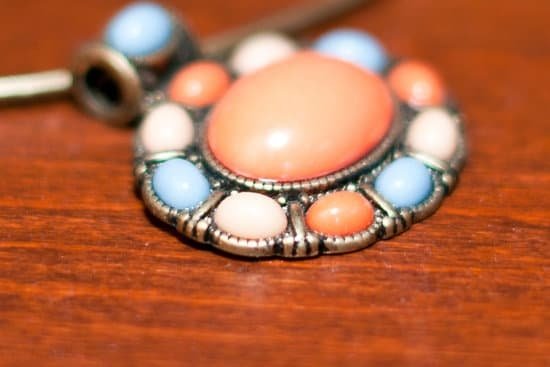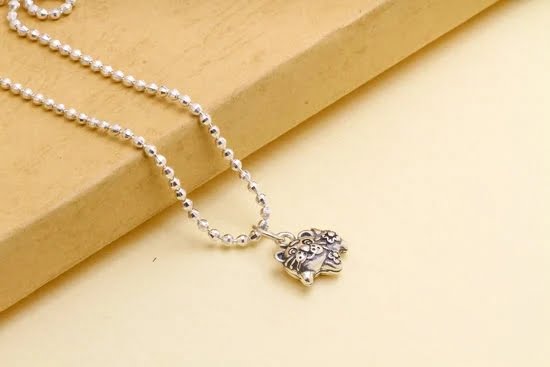Jewelry materials guide can help you make the right decision when purchasing a beautiful jewelry item. Different jewelry pieces require different materials to wear them. All of these materials have benefits and drawbacks that should be taken into account when choosing which one will fit your needs the best.
The most popular material for jewelry is gold. Gold has been used for thousands of years and comes in many alloys, each with its own unique aesthetic appeal and meaning.
Gold is not only durable but also hypoallergenic, resistant to corrosion, easy to handcraft and maintain over time, polished softly with low friction resulting in less scratches. Gold has a rich color that never fades or tarnishes overtime which allows it to look better than silver or other metals over an extended period of time.
Sterling silver is another popular jewelry material due to its cost advantage over gold. Silver is also very malleable and easily crafted into beautiful shapes.
It has a distinctively clean shine that does not require polishing as often as gold does, which makes it easy to maintain over time. Because silver does tarnish if exposed to air and humidity for too long, it’s best to wear it with caution when in certain climates and avoid exposing it to water or too much touch.
Platinum is another choice for those looking for a luxurious feel in their jewelry items. Platinum alloyed with other metals such as copper or palladium will produce different colors including shades of pink and yellow giving you many possibilities from the same metal alloy combinations.
Platinum doesn’t corrode as easily as other metals, making it ideal for pieces being worn daily and needing resilient protection against oxidation or rusting from the environment elements like water or dirt accumulation on skin cells found on the outside layer of skin.
When selecting which jewelry material matches your preference there are several factors at play: budget, allergies, design preferences among others; so make sure you read up on each option before pulling the trigger so you’re satisfied with your purchase top to bottom.
Precious Metals
Gold is the most commonly used metal for jewelry. It’s look ranges from a soft yellow to a bright white. Gold is very malleable and easy to work with which makes it popular for casting and setting stones into, depending on the type of gold chosen (14k, 18k etc). Gold is resistant to corrosion and tarnish making it an excellent choice for long lasting pieces of jewelry.
Silver is naturally white in color with a shiny luster, and like gold, it can be alloyed when creating jewelry but generally only seen in lower karats such as 925. Due to its finer grain, silver is better at holding stones and can provide intricate details compared to other metals. Its natural patina resists corrosion but develops a beautiful aged look over time.
Platinum has become an increasingly popular choice for jewelry due to its natural whiteness and lasting durability over other metals such as gold or silver. Platinum holds gemstones secure due to its high purity and density giving it greater strength than that of gold or silver alloys or mixes. Its natural beauty also requires less maintenance with minimal polishing responsibilities.
Benefits of Precious Metals
- Gold: Malleable, resists tarnish/corrosion
- >Silver: Intricate detailing possible, natural patina resists corrosion
- >Platinum: > High purity/durable setting for gems, little maintenance required
Alloys
Alloys are a type of jewelry material composed of two or more metals, usually combining base metals and a precious metal. Precious alloys incorporate precious metals such as gold, silver and platinum in their composition. Alloys are used for many reasons, the most common being to increase strength or the durability of the metal as well as to change it’s coloration.
Gold alloy is made up of combinations ofgold, copper, zinc and silver. Depending on the ratio of these metals that is used will effect the look, feel and karat rating (purity) of the finished piece. For example 14 karat gold has 58 % gold content while 18k gold has 75% gold in its composition.
Silver alloy is typically composed of sterling silver with copper, zinc or nickel added to it. Sterling silver has a purity level between 92-94%. Similar to how adding different types of metals effects the properties and appearance of gold alloys, adding other elements impacts both how strong silver alloys are and the hue and depth it takes on when heated.
The addition of palladium turns any alloy into palladium alloy which increases malleability in jewelry making. Some popular examples include white gold which uses palladium to givelighter color,rose gold that incorporates copper for its rosy pinkish tone and gray-silver which uses nickel giving it a cool silvery hue.
Types Of Alloy Used In Jewelry Making
- Gold Alloy
- Silver Alloy
- Palladium Alloy
- White Gold
- Grey Silver
Gemstones
Gemstones are known to be a collector’s item, due to their attractive and sparkly nature. They are used as accents in jewelry pieces to make them stand out and add some uniqueness. Gemstones come in a vast variety of colors, shapes, sizes, and textures providing an endless range of possibilities for any type of jewelry design. Each type of gemstone has its own set of characteristics that can be used for identification and classification.
Rocks such as quartz, sapphire, diamond, emerald, and ruby are categorized under gemstones due to their unique physical properties they possess such as specific gravity and hardness. They can range from extremely rare natural stones like the Alexandrite to more common varieties including Cubic Zirconia or lab created stones like Moissanite.
Prices will depend on the size, quality, color clarity and rarity of the stone. Natural gems are normally much pricier than synthetic gems due to their labor intensive creation but offer a greater diversity in color saturation while synthetics tend to last longer with higher durability although often lack natural luster compared to natural gemstones.
Gemstones also have symbolic meaning depending on where they originate from. For example Jade is traditionally viewed as luck symbol for east Asia cultures whereas birthstones where selected based off Roman folklore and each month related to another different gemstone.
Gem selection is based upon personal preference more than anything else in modern day trends with unique combinations seen popping up around the world with designers always trying something new with these beautiful stones all competing in the big wide world of fashion jewelry pieces worldwide.
Colored Stones
The use of colored stones for jewelry dates back to ancient times, when they were believed to have magical properties. Different colors of stone were often associated with certain gods or deities and were believed to bring good luck and protection. Throughout history, different cultures have assigned various meanings to different colors and precious stones.
- Amethyst – Originating from Ancient Greece, Amethyst was believed to prevent intoxication, give its owner courage and strength and divert disaster away from them. It is the birthstone for February and is said to bring wisdom, peace, sobriety and clarity.
- Ruby – Ancient Indian cultures valued ruby as a spiritual stone that signified nobility. Egyptians also treasured it as an expression of the sun gods’ power. It symbolizes wealth, harmony and contentment.
- Opal – In Roman mythology opal was known as ‘Cupid Stone’ because it was thought to be able to attract love. Opal symbolizes faithfulness and confidence which makes them popular as engagement rings.
Emeralds have long been associated with fertility in numerous cultures going back centuries ago. The ancient Romans linked the emerald to Venus – the goddess of love – while the Incas recognized it as a fertility symbol too. The emerald is one of the four precious stones mentioned in the Bible; its deep green color represents beauty, truth and divine love.
Sapphires are among one of the oldest gemstones; their deep blue hue has attracted attention throughout history due both to its rarity and beauty. In Hindu culture sapphire is a royal stone representing divine favor For centuries it has represented trustworthiness, strength, kindness, fidelity and purity Diamonds have fascinated humanity for almost 5000 years since they first started being mined in India over 3000 years ago.
They hold a special place among all gemstones due to their brilliance, clarity and reflective abilities. Historically diamonds were associated with invulnerability or immortality ; they are also said to enable alignment between ones thoughts or feelings offering guidance, stability control.
Non-Precious Metals
Titanium
Titanium is a lightweight yet strong metal option that is very popular for bold, modern and inventive jewelry designs. The grayish-white color of titanium pairs nicely with a variety of gemstones, or it can be left alone as an attractive stand-alone piece.
Titanium is very strong, corrosion-resistant and hypoallergenic making it a great choice for people who have sensitivities to other metals such as nickel. It’s also low maintenance since it won’t tarnish like silver or other metals.
Stainless Steel
Stainless steel is the perfect blend of durability, strength and affordability while still looking modern and chic in the right setting. Not all stainless steel earrings are created equal though. Depending on their quality, some types are harder wearing than others and designed with more luxurious touches such as gemstones set into them for extra sparkle without compromising on price point significantly.
Stainless steel is a great choice for everyday wear due to its strength, affordability and non-corrosive properties. It also never needs polishing or special care like gold and silver do.
Copper & Brass
Copper and brass are both popular metallic options in jewelry designs that create beautiful unique pieces for lovers of earthy tones or color pops with bright enamel applied over the top. Unlike gold plated/filled metal which may tarnish over time due to acidity levels in sweat, copper&brass maintain their color over time without any difficulty despite constant wear and tear.
Copper has an inherent antimicrobial property too which makes it great if you want something not only looks beautiful but safe against any bacterial build up. Additionally, brass jewelry provides lighter weight but robust composition that allows more intricate designing details which makes this another great material option that can hold its own without costing too much money either.
Synthetic Stones
Synthetic stones, or lab-created stones, have become increasingly popular materials for jewelry makers in the last few years. These man-made gems come incredibly close to the look and feel of their traditional counterparts, but without the environmental impact or expensive pricing tag associated with natural stones. Synthetized gems are a great option for those who are looking to add a unique twist to their jewelry designs.
Lab-created synthetic stones provide a wide variety of benefits to jewelers, specifically when compared to their natural contemporaries. For starters, synthetics are much more affordable as well as easier to cut and polish than real stones. Additionally, they often possess better clarity and color saturation due to consistent chemical compositions while also ensuring there is no environmental damage incurred in the mining process of sourcing them. Finally, many synthetics can exhibit improved durability and hardness measurements over natural materials.
It’s worth noting that, while synthetic gems lack the inherent value conferred by thousands of years of history and economics like real gemstones, this doesn’t mean they have no environmental impacts at all. There is still a cost associated with producing synthetics although this cost tends be far lower than what is involved in extracting naturally occurring minerals in mines.
Synthetic gem production requires energy inputs such as electricity which leads to increased emissions as well as potential pollution caused by releasing waste water into surrounding areas.
- Synthetic Stones offer affordability
- They are easier to cut and polish than real stones
- They often possess better clarity and color saturation
- Synthetics can exhibit improved durability over Natural materials
- Production costs tend be far lower
- Still require energy inputs leading to emissions/pollution
Care and Maintenance
Proper care and maintenance of jewelry is essential to ensuring the pieces maintain their quality for years to come. Depending on the material of the jewelry, there are various methods for properly cleaning and caring for your pieces.
For silver jewelry or pieces with other precious metals, use a specialized polish such as a mild detergent designed specifically for removing tarnish from these materials. This type of detergent will be gentle enough to avoid damaging the metal while still giving it a good clean. It’s also important to store silver jewelry in a dry place away from humidity, as that can cause corrosion more quickly than with other metals.
Gold and brass jewelry typically don’t require any specialized solutions, but it’s still important to take care when cleaning them. Using warm water and a mild soap can help keep any dirt away without putting too much strain on the metal or stones.
Again, proper storage is key here; both gold and brass are prone to tarnishing if left in humid environments, so keep them (preferably in separate containers) in a cool, dry area inside your home whenever possible.
Finally, if you have jewelry made of gems or semi-precious stones, then special attention must be paid when it comes to cleaning individual pieces; as some may break down more readily than others depending on how hard they were made or what type of material they’re made from.
For most gemstone jewellery you should always avoid abrasive liquids and cloths that can scratch softer stones like opal or pearl – use only lukewarm water with a bit of gentle dish soap instead.
And definitely avoid using tissue paper when polishing; this could leave small bits behind which would harm the surface of your jewels over time. When storing jewels make sure they are separated by fabric pockets inside jewelry boxes to prevent accidental scratching against each other and keep dust and dirt out as much as possible.

Welcome to my jewelry blog! My name is Sarah and I am the owner of this blog.
I love making jewelry and sharing my creations with others.
So whether you’re someone who loves wearing jewelry yourself or simply enjoys learning about it, be sure to check out my blog for insightful posts on everything related to this exciting topic!





